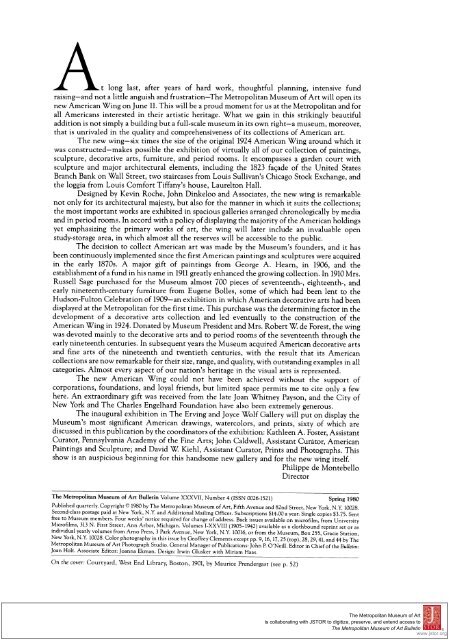The Metropolitan Museum of Art Bulletin, v. 37, no. 4
The Metropolitan Museum of Art Bulletin, v. 37, no. 4
The Metropolitan Museum of Art Bulletin, v. 37, no. 4
You also want an ePaper? Increase the reach of your titles
YUMPU automatically turns print PDFs into web optimized ePapers that Google loves.
^ ~A ^ t long last, after years <strong>of</strong> hard work, thoughtful planning, intensive fund<br />
raising-and <strong>no</strong>t a little anguish and frustration-<strong>The</strong> <strong>Metropolitan</strong> <strong>Museum</strong> <strong>of</strong> <strong>Art</strong> will open its<br />
new American Wing on June 11. This will be a proud moment for us at the <strong>Metropolitan</strong> and for<br />
all Americans interested in their artistic heritage. What we gain in this strikingly beautiful<br />
addition is <strong>no</strong>t simply a building but a full-scale museum in its own right-a museum, moreover,<br />
that is unrivaled in the quality and comprehensiveness <strong>of</strong> its collections <strong>of</strong> American art.<br />
<strong>The</strong> new wing-six times the size <strong>of</strong> the original 1924 American Wing around which it<br />
was constructed-makes possible the exhibition <strong>of</strong> virtually all <strong>of</strong> our collection <strong>of</strong> paintings,<br />
sculpture, decorative arts, furniture, reand period rooms. It encompasses a garden court with<br />
sculpture and major architectural elements, including the 1823 facade <strong>of</strong> the United States<br />
Branch Bank on Wall Street, two staircases from Louis Sullivan's Chicago Stock Exchange, and<br />
the loggia from Louis Comfort Tiffany's house, Laurelton Hall.<br />
Designed by Kevin Roche, John Dinkeloo and Associates, the new wing is remarkable<br />
<strong>no</strong>t only for its architectural majesty, but also for the manner in which it suits the collections;<br />
the most important works are exhibited in spacious galleries arranged chro<strong>no</strong>logically by media<br />
and in period rooms. In accor with a policy <strong>of</strong> displaying the majority <strong>of</strong> the American holdings<br />
yet emphasizing the primary works <strong>of</strong> art, the wing will later include an invaluable open<br />
study-storage area, in which almost all the reserves will be accessible to the public.<br />
<strong>The</strong> decision to collect American art was made by the <strong>Museum</strong>'s founders, and it has<br />
been continuously implemented since the first American paintings and sculptures were acquired<br />
in the early 1870s. A major gift <strong>of</strong> paintings from George A. Hearn, in 1906, and the<br />
establishment <strong>of</strong> a fund in his name in 1911 greatly enhanced the growing collection. In 1910 Mrs.<br />
Russell Sage purchased for the <strong>Museum</strong> almost 700 pieces <strong>of</strong> seventeenth-, eighteenth-, and<br />
early nineteenth-century furniture from Eugene Bolles, some <strong>of</strong> which had been lent to the<br />
Hudson-Fulton Celebration <strong>of</strong> 1909-an exhibition in which American decorative arts had been<br />
displayed at the <strong>Metropolitan</strong> for the first time. This purchase was the determining factor in the<br />
development <strong>of</strong> a decorative arts collection and led eventually to the construction <strong>of</strong> the<br />
American Wing in 1924. Donated by <strong>Museum</strong> President and Mrs. Robert W de Forest, the wing<br />
was devoted mainly to the decorative arts and to period rooms <strong>of</strong> the seventeenth through the<br />
early nineteenth centuries. In subsequent years the <strong>Museum</strong> acquired American decorative arts<br />
and fine arts <strong>of</strong> the nineteenth and twentieth centuries, with the result that its American<br />
collections are <strong>no</strong>w remarkable for their size, range, and quality, with outstanding examples in all<br />
categories. Almost every aspect <strong>of</strong> our nation's heritage in the visual arts is represented.<br />
<strong>The</strong> new American Wing could <strong>no</strong>t have been achieved without the support <strong>of</strong><br />
corporations, foundations, and loyal friends, but limited space permits me to cite only a few<br />
here. An extraordinary gift was received from the late Joan Whitney Payson, and the City <strong>of</strong><br />
New York and <strong>The</strong> Charles Engelhard Foundation have also been extremely generous.<br />
<strong>The</strong> inaugural exhibition in <strong>The</strong> Erving and Joyce Wolf Gallery will put on display the<br />
<strong>Museum</strong>'s most significant American drawings, watercolors, and prints, sixty <strong>of</strong> which are<br />
discussed in this publication by the coordinators <strong>of</strong> the exhibition: Kathleen A. Foster, Assistant<br />
Curator, Pennsylvania Academy <strong>of</strong> the Fine <strong>Art</strong>s; John Caldwell, Assistant Curator, American<br />
Paintings and Sculpture; and David W. Kiehl, Assistant Curator, Prints and Photographs. This<br />
show is an auspicious beginning for this handsome new gallery and for the new wing itself.<br />
Philippe de Montebello<br />
Director<br />
<strong>The</strong> <strong>Metropolitan</strong> <strong>Museum</strong> <strong>of</strong> <strong>Art</strong> <strong>Bulletin</strong> Volume XXXVII, Number 4 (ISSN 0026-1521) Spring 1980<br />
Published quarterly. Copyright ( 1980 by <strong>The</strong> <strong>Metropolitan</strong> <strong>Museum</strong> <strong>of</strong> <strong>Art</strong>, Fifth Avenue and 82nd Street, New York, N.Y. 10028.<br />
Second-class postage paid at New York, N.Y. and Additional Mailing Offices. Subscriptions $14.00 a year. Single copies $3.75. Sent<br />
free to <strong>Museum</strong> members. Four weeks' <strong>no</strong>tice required for change <strong>of</strong> address. Back issues available on micr<strong>of</strong>ilm, from University<br />
Micr<strong>of</strong>ilms, 313 N. First Street, Ann Arbor, Michigan. Volumes I-XXVIII (1905-1942) available as a clothbound reprint set or as<br />
individual yearly volumes from Ar<strong>no</strong> Press, 3 Park Avenue, New York, N.Y. 10016, or from the <strong>Museum</strong>, Box 255, Gracie Station,<br />
New York, N.Y. 10028. Color photography in this issue by Ge<strong>of</strong>frey Clements except pp. 9, 16, 17, 25 (top), 28, 29, 41, and 44 by <strong>The</strong><br />
<strong>Metropolitan</strong> <strong>Museum</strong> <strong>of</strong> <strong>Art</strong> Photograph Studio. General Manager <strong>of</strong> Publications: John P. O'Neill. Editor in Chief <strong>of</strong> the <strong>Bulletin</strong>:<br />
Joan Holt. Associate Editor: Joanna Ekman. Design: Irwin Glusker with Miriam Haas.<br />
On the cover: Courtyard, West End Library, Boston, 1901, by Maurice Prendergast (see p. 52)<br />
<strong>The</strong> <strong>Metropolitan</strong> <strong>Museum</strong> <strong>of</strong> <strong>Art</strong><br />
is collaborating with JSTOR to digitize, preserve, and extend access to<br />
<strong>The</strong> <strong>Metropolitan</strong> <strong>Museum</strong> <strong>of</strong> <strong>Art</strong> <strong>Bulletin</strong> ®<br />
www.jstor.org

















